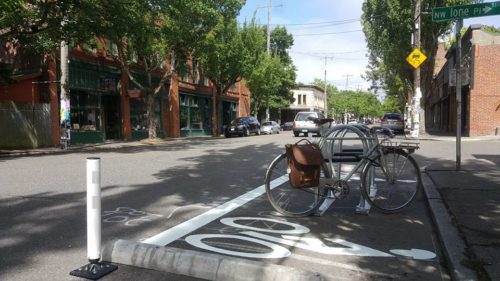Bike Parking
Bike Racks
Design Standards
Bike racks must have the following characteristics:
- Have a no-maintenance finish that won’t chip, peel, or rust. Galvanized steel finishes are preferred;
- Have a minimum height of 32 inches so it is not a tripping hazard;
- Are installed as close to, without being directly in front of, the main entrance(s) of a building or site; and
- Have adequate clearance from driveways, curb ramps, transit loading areas and immediately adjacent to shelters, and utility poles.
- At high volume locations, consider the widest variety of bicycles (family bikes and mobility trikes) and allow for greater clearances than the standards, referenced above.
For more information on bike parking, see Adaptive Design.
The SDOT bicycle rack program website has sample racks and more information, see also the Association of Pedestrian and Bicycle Professionals’ bicycle parking guidelines. SDOT will assume ownership and maintenance of standard bicycle racks once they are installed if they are eligible for SDOT inventory. If the bicycle rack is not eligible, SDOT requires specially designed racks to remain under Public Space permit from the adjacent property owner.
Private, off-street (long term) bicycle parking requirements are specified in the Land Use Code.
- SMC 23.49.019 Downtown Parking Quantity Requirements
- SMC 23.54.015 Required Parking
- SMC 23.54.016 Major Institutions Parking and transportation
- SMC 23.54.020 Parking Quantity Exceptions
On-Street Bike Parking
On-street (short-term) bike parking may be provided in the form of corrals or clusters of inverted U racks.
Design guidance
- Selection of the specific type of on-street bike parking (e.g. corral or U rack cluster) is based on available space as well as demand for bicycle parking.
- On-street bike parking must be oriented so that bicyclists can safely enter and exit without conflicting with motor vehicles or pedestrians.
- Locate on-street bike parking close to, without being directly in front of, entrances of high demand locations for bicyclists.
- Bike corrals typically provides parking for 6 bikes (per single parking space) or typically 18 bikes for two 10′ parking spaces.
- On street bike corrals can take the place of one to two vehicle parking spaces where bicycle parking demand is high and sidewalk space in constrained.
- Placing bike corrals near intersections allows them to function like curb extensions, providing visibility and protected space for crossing pedestrians as well as bicyclists entering and leaving the corral. Pavement markings, flexible bollards and wheel stops are required to define the on-street parking space.
- Bike corrals provide increased visibility for bicycle parking and opportunities for the incorporation of public art.
- Avoid locating bike corrals in areas where public utilities are located or where curbsides are prone to flooding.
The SDOT bicycle rack program website provides information on requesting a bike corral.

